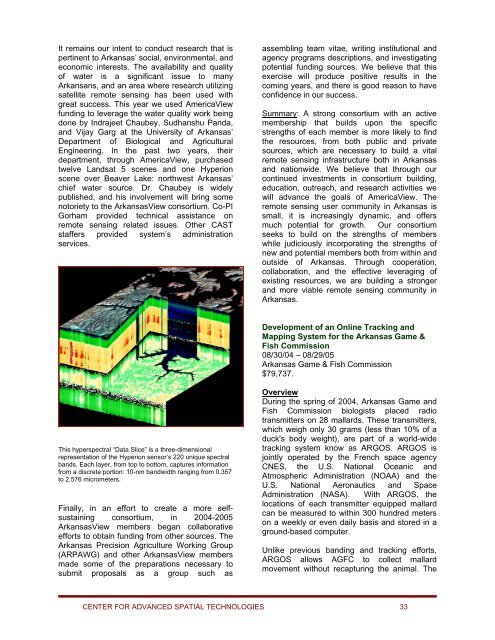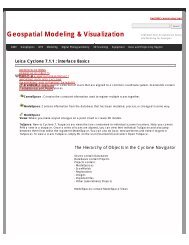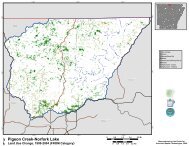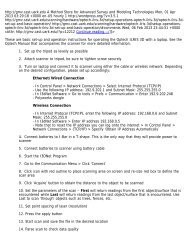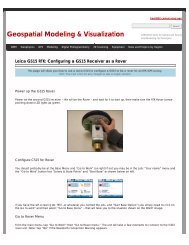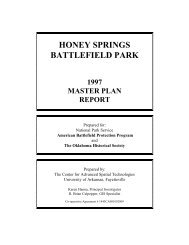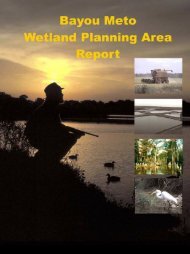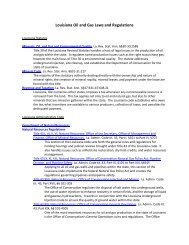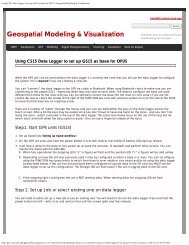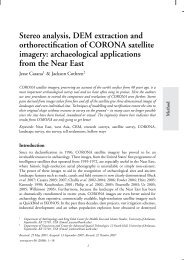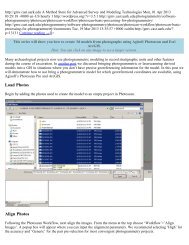CAST Fiscal Year 2004-2005 Annual Report - Center for Advanced ...
CAST Fiscal Year 2004-2005 Annual Report - Center for Advanced ...
CAST Fiscal Year 2004-2005 Annual Report - Center for Advanced ...
You also want an ePaper? Increase the reach of your titles
YUMPU automatically turns print PDFs into web optimized ePapers that Google loves.
It remains our intent to conduct research that is<br />
pertinent to Arkansas’ social, environmental, and<br />
economic interests. The availability and quality<br />
of water is a significant issue to many<br />
Arkansans, and an area where research utilizing<br />
satellite remote sensing has been used with<br />
great success. This year we used AmericaView<br />
funding to leverage the water quality work being<br />
done by Indrajeet Chaubey, Sudhanshu Panda,<br />
and Vijay Garg at the University of Arkansas’<br />
Department of Biological and Agricultural<br />
Engineering. In the past two years, their<br />
department, through AmericaView, purchased<br />
twelve Landsat 5 scenes and one Hyperion<br />
scene over Beaver Lake: northwest Arkansas’<br />
chief water source. Dr. Chaubey is widely<br />
published, and his involvement will bring some<br />
notoriety to the ArkansasView consortium. Co-PI<br />
Gorham provided technical assistance on<br />
remote sensing related issues. Other <strong>CAST</strong><br />
staffers provided system’s administration<br />
services.<br />
assembling team vitae, writing institutional and<br />
agency programs descriptions, and investigating<br />
potential funding sources. We believe that this<br />
exercise will produce positive results in the<br />
coming years, and there is good reason to have<br />
confidence in our success.<br />
Summary: A strong consortium with an active<br />
membership that builds upon the specific<br />
strengths of each member is more likely to find<br />
the resources, from both public and private<br />
sources, which are necessary to build a vital<br />
remote sensing infrastructure both in Arkansas<br />
and nationwide. We believe that through our<br />
continued investments in consortium building,<br />
education, outreach, and research activities we<br />
will advance the goals of AmericaView. The<br />
remote sensing user community in Arkansas is<br />
small, it is increasingly dynamic, and offers<br />
much potential <strong>for</strong> growth. Our consortium<br />
seeks to build on the strengths of members<br />
while judiciously incorporating the strengths of<br />
new and potential members both from within and<br />
outside of Arkansas. Through cooperation,<br />
collaboration, and the effective leveraging of<br />
existing resources, we are building a stronger<br />
and more viable remote sensing community in<br />
Arkansas.<br />
Development of an Online Tracking and<br />
Mapping System <strong>for</strong> the Arkansas Game &<br />
Fish Commission<br />
08/30/04 – 08/29/05<br />
Arkansas Game & Fish Commission<br />
$79,737.<br />
This hyperspectral “Data Slice” is a three-dimensional<br />
representation of the Hyperion sensor’s 220 unique spectral<br />
bands. Each layer, from top to bottom, captures in<strong>for</strong>mation<br />
from a discrete portion: 10-nm bandwidth ranging from 0.357<br />
to 2.576 micrometers.<br />
Finally, in an ef<strong>for</strong>t to create a more selfsustaining<br />
consortium, in <strong>2004</strong>-<strong>2005</strong><br />
ArkansasView members began collaborative<br />
ef<strong>for</strong>ts to obtain funding from other sources. The<br />
Arkansas Precision Agriculture Working Group<br />
(ARPAWG) and other ArkansasView members<br />
made some of the preparations necessary to<br />
submit proposals as a group such as<br />
Overview<br />
During the spring of <strong>2004</strong>, Arkansas Game and<br />
Fish Commission biologists placed radio<br />
transmitters on 28 mallards. These transmitters,<br />
which weigh only 30 grams (less than 10% of a<br />
duck's body weight), are part of a world-wide<br />
tracking system know as ARGOS. ARGOS is<br />
jointly operated by the French space agency<br />
CNES, the U.S. National Oceanic and<br />
Atmospheric Administration (NOAA) and the<br />
U.S. National Aeronautics and Space<br />
Administration (NASA). With ARGOS, the<br />
locations of each transmitter equipped mallard<br />
can be measured to within 300 hundred meters<br />
on a weekly or even daily basis and stored in a<br />
ground-based computer.<br />
Unlike previous banding and tracking ef<strong>for</strong>ts,<br />
ARGOS allows AGFC to collect mallard<br />
movement without recapturing the animal. The<br />
CENTER FOR ADVANCED SPATIAL TECHNOLOGIES 33


